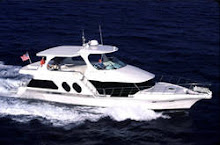
You may feel ready to abandon life on land, cut the lines and move onboard a boat. Knowing what you want, does not mean your dog is automatically ready to cruise, and for liveaboard life. Before you take your dog onboard, you will need to learn a lot about yourselves, your boat, and your relationship with your dog.
Cabin Train Your Dog -Begin by bringing the dog to your boat long before you make the big move. Have a designated place for the dog's bed, food, water, and a few water toys.

Once the dog is comfortable with the inside of your boat, start up the engines or if a sail boat, turn on the motor, so doggie can get used to the sound and feel of being underway.
Deck Train Your Dog before you go cruising. Some liveaboards try a little box of sod or a fake grass mat for the dog to use when they cannot get the dog to land; nothing worked with our dog until we got a heads up from a liveaboard with 3 dogs. She put us on to the Pet-a-Potty.
We purchased one on the internet, and it worked right away. We keep it topside, and when Bandit needs it, she does use it. What a relief! This wonderful item allows us to cruise to Catalina Island and other wonderful spots where there are no slips, just moorings.
For small dogs get the PETaPOTTY Mini.
We would not cruise without it.
If your dog will be playing in the water, rig a ramp that the dog can use to get back on the boat. Train the dog to use it. Leave the ramp down (except when you are underway) so if the dog falls in, it can self-rescue.
Click Here to Check it Out
SEE RAMP IN ACTION - WATCH VIDEO -
Rig a tether to keep your dog from going overboard accidentally. This is especially important if you leave the dog on the deck when you are not aboard, and when you are cruising. You must have a dog life jacket that fits and use it when appropriate. If the life jacket is off, a harness is a better handle than a collar. I had to rescue a neighbor's dog who jumped off his boat and fell in when the owners were not there. Because the frightened dog was trapped between the side of the boat and the dock, I could not get him out of the water without help. If he'd had on a life vest with a handle or harness, I could have rescued him myself.
If you are going to choose a liveaboard dog, consider some desirable attributes. A small dog is easier to get on and off the boat and requires less food to store. All dogs need exercise, but a breed that doesn’t require a lot or an older pet might be preferable. A toy breed might get enough exercise just playing with a toy in the cabin.
A female or neutered male may get along better with new dogs they meet. A non-shedding breed would be a good idea. Poodles, Schnauzers, and Portuguese Waterdogs are some of these breeds.
Check with your vet to be sure the dog is healthy enough to go cruising. Be sure to get a Serious First Aid Kit For Your Pet. Hopefully you will never need it, but it is best to be prepared, especially if you are off cruising and days away from a veterinarian.




No comments:
Post a Comment